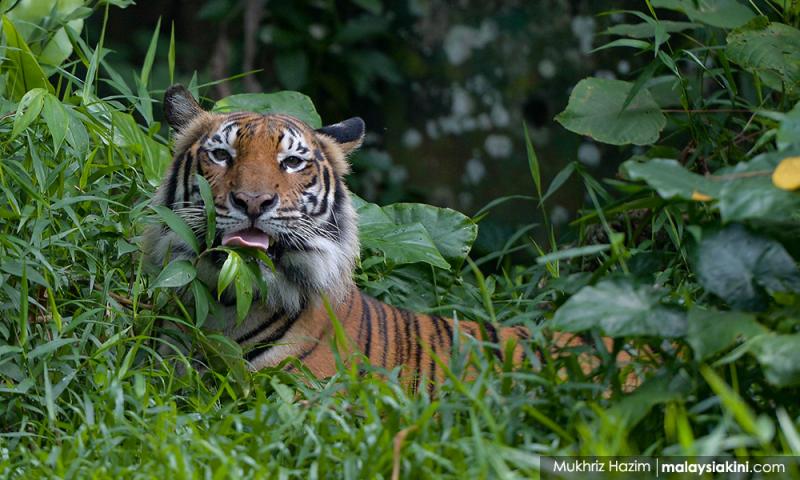LETTER | Captive breeding of tigers is not conservation
LETTER | The proposal by the Department of Wildlife and National Parks (Perhilitan) to breed the critically endangered Malayan tiger (Panthera tigris jacksoni) at the National Tiger Conservation Centre for release and ‘rewilding’ raises many reasons for concern.
The reason for the decline in the population of Malayan tigers is not that the tigers are not mating or breeding enough. Tigers, like most members of the cat family, are prolific breeders, which explains why the number of tigers in captivity continues to rise worldwide, even as wild tiger populations continue to be decimated.
The Malayan tiger is critically endangered in the wild because of habitat destruction, diminishing prey species, poaching, and the wildlife trade. Human encroachment into tiger habitats, usually for agriculture, also increases the risk of human-wildlife conflict. In such conflicts, tigers often die from being shot or snared by plantation or livestock owners, or from diseases such as canine distemper virus when they come in contact with infected dogs introduced by humans.
Researchers from the University of Exeter found in a 2008 study that most captive-born predators do not survive after being released into the wild. The chances of carnivores such as tigers and wolves surviving freedom are only 33 percent, due to their lack of hunting skills and lack of fear of humans, and susceptibility to viruses and diseases.
Conservation organisation Born Free Foundation also points out that wild tigers born in human-controlled environments such as wildlife reserves and zoos are unlikely to be successfully released and will often spend the rest of their lives in captivity.
Part of the reason is genetics. There are not enough tigers in breeding programmes to sustain genetic diversity over a long period of time. The Association of Zoos and Aquariums tries to diversify captive gene pools by exchanging breeding animals between zoos, but genetic drift and genetic bottlenecks can still occur. Genetic weaknesses in breeding stocks can result in deadly diseases, as seen in India’s effort to breed the Asiatic lion.
Captive breeding programmes should not take too many animals out of the wild for breeding programmes either, as it will remove their genes from circulation in the wild.
It takes over a year for tiger cubs to learn how to stalk, catch, and kill their prey from their mothers. According to conservation charity Flora & Fauna International, captive tigers, whether they have been hand-reared by humans or raised with their mothers, lack the vital exposure from wild and experienced mothers to be predators.
There is also the risk that captive-bred wild tigers, even if raised with their mothers and other tigers, will associate humans with food and lose their fear of vehicles. Upon release, they could pose a bigger threat to humans and livestock than wild tigers, as they are less likely to avoid human habitation and farms.
Efforts around the globe to reintroduce captive-bred tigers into the wild has not been met with much success. After over 30 years of expert conservation efforts and successfully breeding over 1,000 Siberian tigers in captivity, China has still not been able to release even one of these tigers into the wild. Kazakhstan has been trying to reintroduce Amur or Siberian tigers into its Balkhash region, but the project has not borne any results yet.
India successfully released Bengal tigers in the Panna and Sariska Tiger Reserves as part of its Tiger Reintroduction Project, but researchers, unfortunately, found that the released tigers were not breeding successfully, presumably due to stress caused by the presence of human activity near the tiger reserves. This strongly indicates that reducing human activity near wildlife habitats is still key to their protection and conservation.
Being able to have enough living adult tigers to release into a designated area is not a measure of success. Success can only be said to be achieved when reintroduced tigers are able to survive, thrive, and breed. This means that we need to invest at least as much energy and resources in the protection of wild habitats as in the captive breeding of the Malayan tiger.
World Wide Fund for Nature (WWF)’s Tigers Alive Initiative has pointed out that “reintroducing tigers is the easier part, protecting the site and prey base is even more complex”. Not only must captive-bred tigers be trained to hunt and survive in the wild, but there must also be suitable prey and appropriate breeding partners in the area marked for their reintroduction.
Due to deforestation, habitat destruction, lack of prey species, and poaching, there are not many suitable habitats left in Peninsular Malaysia for tigers to be released into. There is not much use in creating a thriving captive population of tigers if we continue to clear primary rainforests for development and agricultural projects. To maintain a healthy wild tiger population, we need healthy ecosystems.
In addition, professionals in the field of tiger conservation agree that to stop the extinction of wild tigers, there must be comprehensive poaching prevention strategies. This is why the Royal Malaysia Police (PDRM)’s recent announcement of a stricter crackdown on the wildlife trade and firearm possession is such welcome news.
The captive breeding of tigers cannot help to restore wild populations unless there is an end to poaching and the trade in tiger parts. There must be stricter law enforcement and harsher penalties for wildlife crimes, and Malaysia must play its part in helping to incapacitate wildlife trafficking networks.
The resources allocated for this ambitious project to breed the Malayan tiger in captivity should instead be redirected to conserving and protecting wild habitats and the remaining wild tigers, and to the prevention of poaching and wildlife trafficking.
The views expressed here are those of the author/contributor and do not necessarily represent the views of Malaysiakini.
RM12.50 / month
- Unlimited access to award-winning journalism
- Comment and share your opinions on all our articles
- Gift interesting stories to your friends
- Tax deductable
